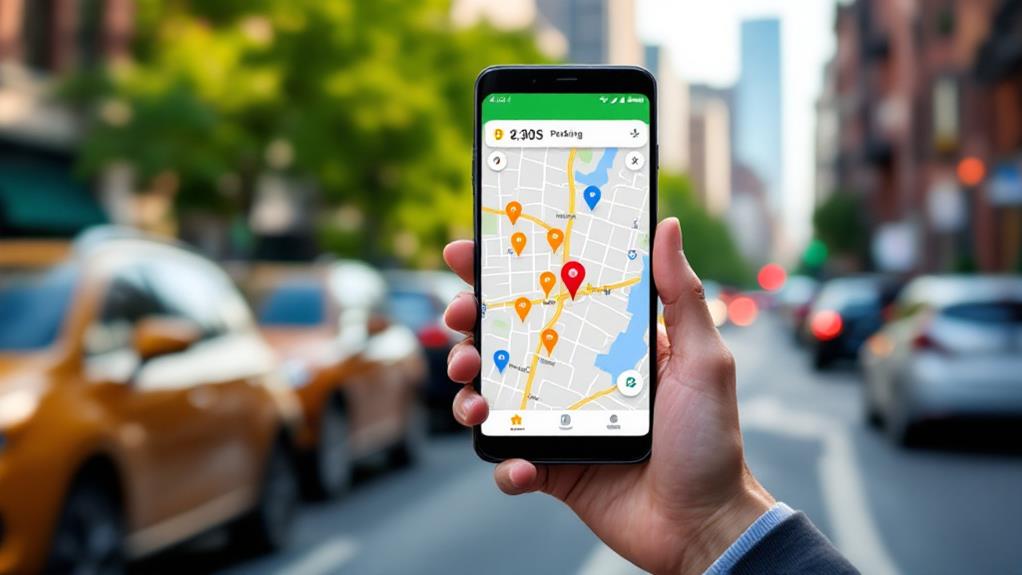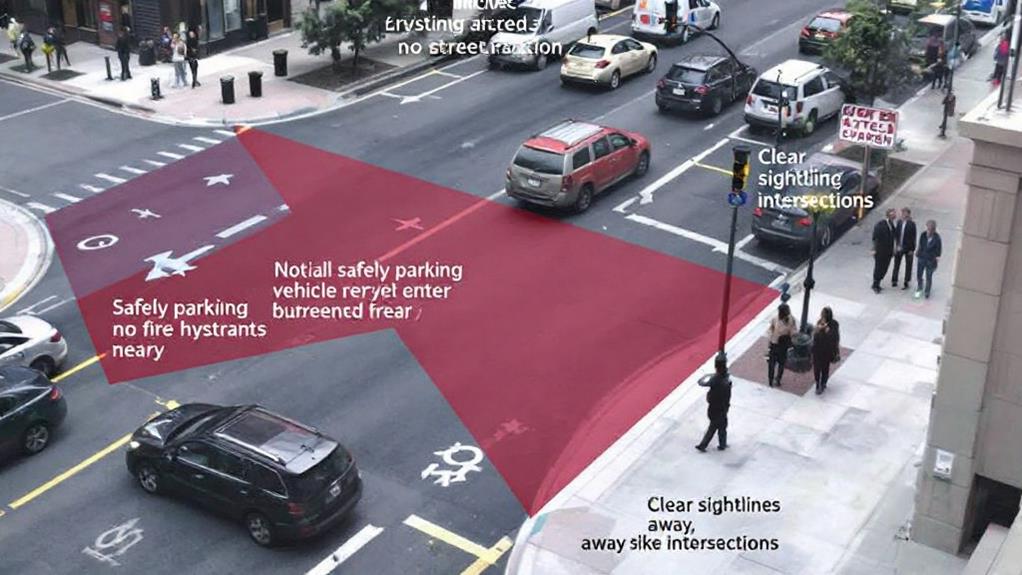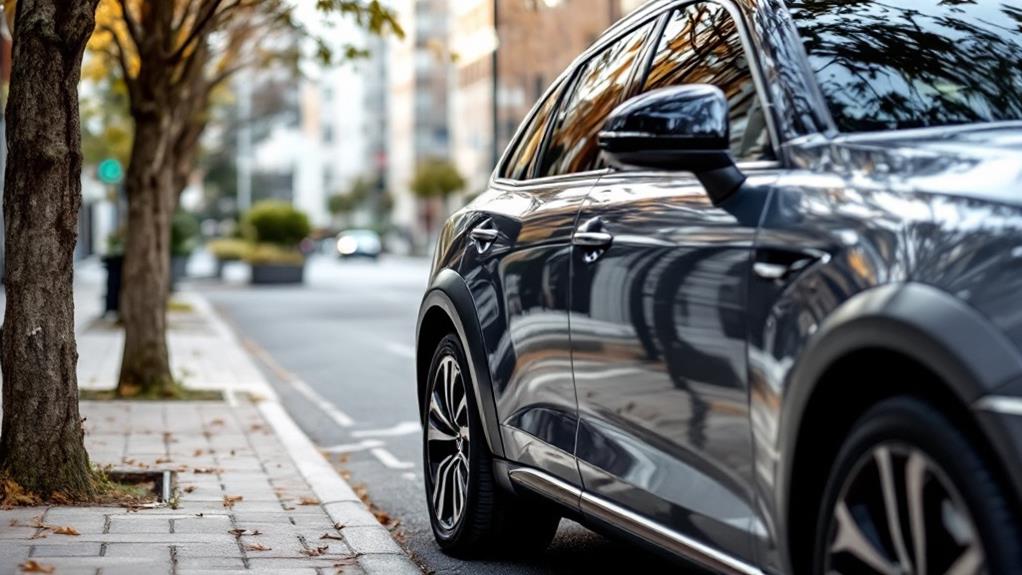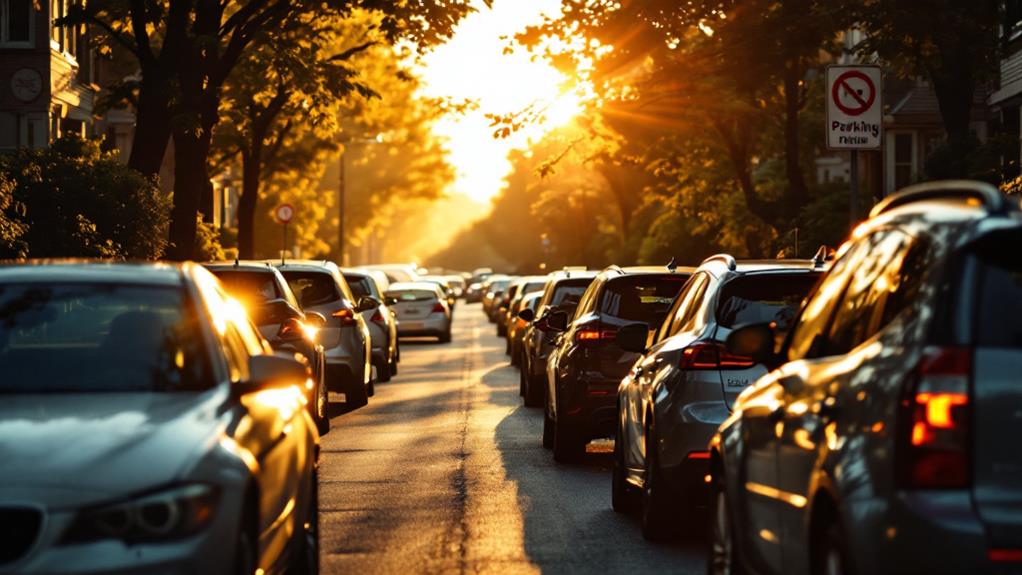Understanding Street Parking Restrictions: A Beginner's Guide

To traverse street parking restrictions, start by understanding curb color codes. Red means no parking, yellow indicates loading zones, blue is for handicapped spaces, and green signifies limited time parking. Always check posted signs and meters for specific time limits. Be aware of designated zones like loading areas and construction sites. Avoid hazardous practices like blocking fire hydrants or parking too close to corners. Respect accessibility spaces and follow seasonal regulations. Remember to park courteously, leaving enough room for others. By commanding these basics, you'll be well on your way to becoming a savvy street parker.
Curb Color Codes
Ever wondered what those colorful curbs mean when you're looking for a parking spot? Understanding curb color codes is essential for avoiding parking tickets and locating the appropriate place to leave your vehicle. Each color serves a specific purpose and indicates different parking restrictions.
Red curbs are a clear signal to stay away. They mark "No Parking" zones, often near fire hydrants or emergency access areas. You'll want to steer clear of these spots to avoid fines and potential hazards. Yellow curbs indicate "Loading/Unloading" zones. These areas have time limits, so check nearby street signs for specific durations if you need to make a quick stop.
Blue striped spaces are reserved for drivers with handicapped permits only. Respect these designations to facilitate accessibility for those who need it. Green striped spaces signify "Limited Parking" with time restrictions. Again, look for street signs that specify the allowed duration. Ultimately, white zones are for "Passenger Loading" only, typically found near building entrances or busy areas.
Time Limits and Meters
Time is money, and nowhere is this more evident than in the world of street parking. When you're searching for parking spots, it's imperative to be aware of the time limits associated with each space. Exceeding these limits can result in costly parking tickets, so always check for posted signs or meters before leaving your vehicle.
Different areas have varying time restrictions. Green spaces typically allow for quick stops, with limits ranging from 10 to 20 minutes. In commercial areas, you'll often find two-hour parking zones, giving you ample time for shopping or dining. Diagonal parking spaces also have specific time limits, which can vary by location, so be sure to double-check before parking.
Designated Parking Zones
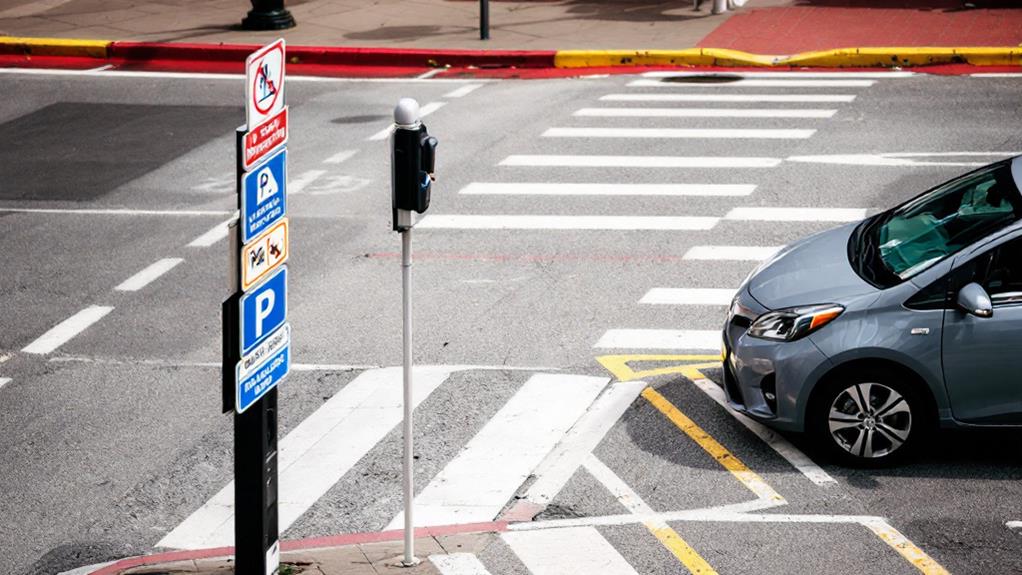
While time limits are important to understand, you'll also need to be aware of designated parking zones. These zones have specific rules and restrictions that you must follow to avoid fines or towing.
Handicapped spaces are one of the most critical parking zones to recognize. You'll need a valid placard or license plate to park in these spots legally. Loading and unloading zones are another common type, typically allowing short-term use for 10-20 minutes. Be sure to check posted signs for specific time limits in these areas.
Construction zones may have temporary parking restrictions that change as work progresses. Always pay attention to signs and barriers in these areas. Diagonal parking spaces often come with their own set of rules, including specific time limits you'll need to observe.
Curb colors are another important indicator of parking zones and restrictions. Red, yellow, and blue curbs each signify different rules for parking. For example, red curbs usually indicate no parking at any time, while yellow may allow brief stops for loading or unloading.
Hazardous Parking Practices
Several common parking practices can pose serious hazards to public safety and traffic flow. You'll want to avoid these dangerous habits to keep yourself and others safe on the road.
One of the most vital rules is to never park in front of a fire hydrant. Doing so can block emergency access during essential moments when firefighters need to connect their hoses. Similarly, parking too close to a stop sign or street corner reduces visibility for turning vehicles, potentially causing accidents.
Parking in the middle of the road is another hazardous practice that severely disrupts traffic flow. It's not only inconsiderate but also dangerous for other drivers who may need to swerve around your vehicle unexpectedly.
Be aware of "No Parking" zones, which are often enforced on specific days or times. Ignoring these restrictions can result in a costly ticket. Additionally, parking in red zones near driveways obstructs access for residents and emergency vehicles.
Safety Tips for Street Parking
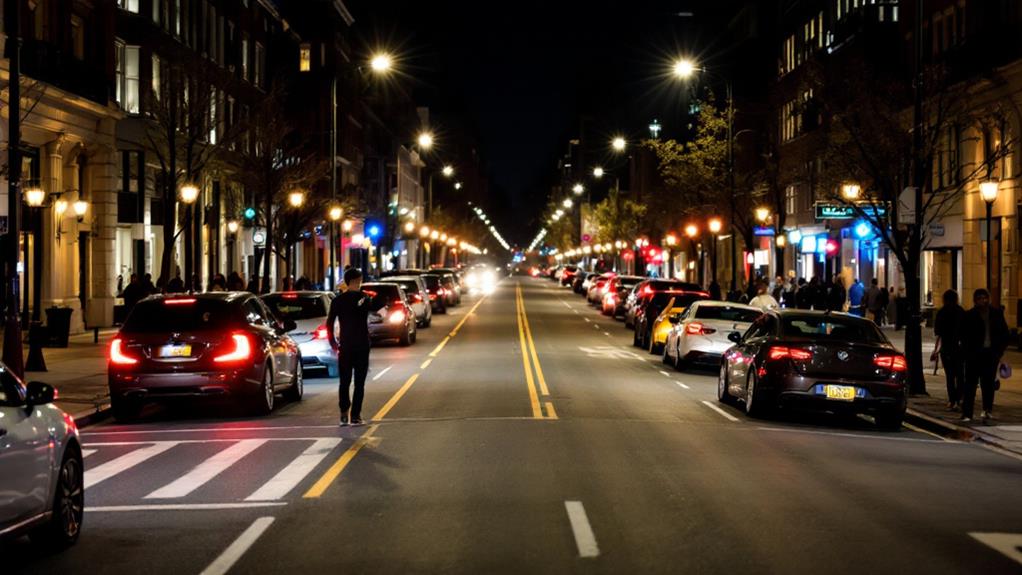
To safeguard your safety and evade potential fines when parking on the street, it's imperative to adhere to some essential guidelines. When you park safely, you're not only protecting yourself but also ensuring the safety of others and maintaining smooth traffic flow.
Always be mindful of fire hydrants and avoid parking in front of them. These areas need to remain clear for emergency access. Similarly, don't park in the middle of the road, as this obstructs traffic and can lead to accidents. When street parking, be cautious about parking too close to corners. This reduces visibility for turning vehicles and can create dangerous situations.
Pay attention to color-coded zones, especially red zones, which indicate "No Parking" areas. Respecting these markings is indispensable for maintaining order and safety on the streets. Additionally, be aware of time limits on parking spaces. Exceeding these limits can result in costly parking tickets.
Understanding Parking Signs
Parking signs can often seem like a puzzle to decipher, but understanding them is essential for avoiding tickets and staying safe on the streets. To comprehend parking rules, you'll need to familiarize yourself with the color-coded curb system. Red curbs indicate absolute "No Parking" zones, while yellow curbs are for loading and unloading with time restrictions. Blue striped spaces are reserved for handicapped drivers with a valid placard or license plate number.
Green striped spaces offer limited parking with time constraints, typically 10-20 minutes. White zones are exclusively for passenger loading. Always check nearby signs for specific time limits, especially in commercial areas where two-hour restrictions are common. Remember, parking in front of fire hydrants or in the middle of the road is never allowed and can lead to hazardous situations.
Pay close attention to signs indicating "No Parking" on designated days, as these restrictions are strictly enforced. When using loading zones or other specially designated areas, be aware of their specific rules and time limits. By carefully observing these parking signs and color codes, you'll traverse street parking with confidence and avoid unwanted fines.
Avoiding Common Parking Violations
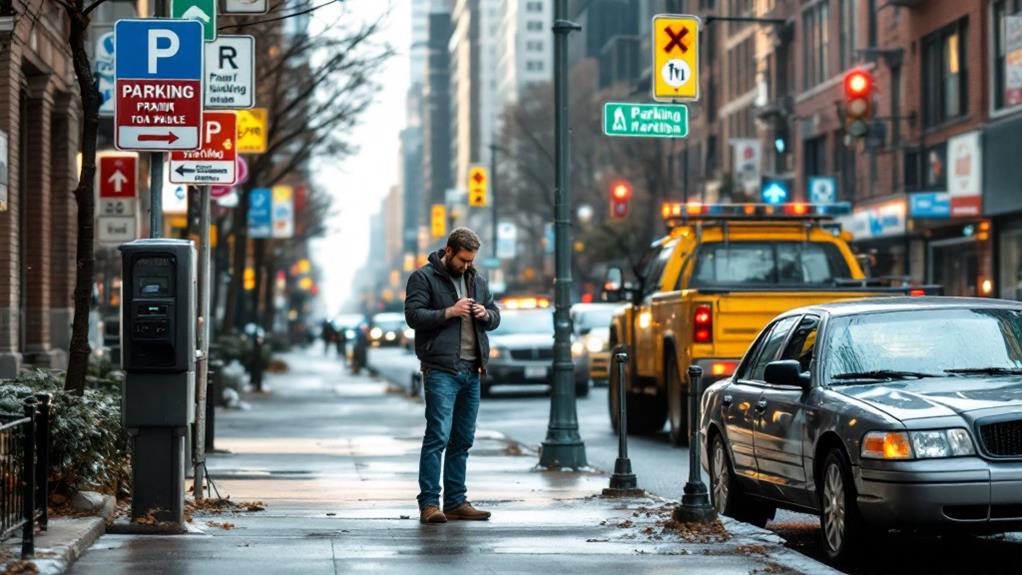
Common parking violations can be easily avoided with a bit of knowledge and attention to detail. Whether you're navigating the busy streets of New York City or searching for a spot in San Francisco, understanding and following parking rules is paramount.
First, always check the curb color before parking. Red curbs indicate no parking zones, and leaving your car there can result in a ticket and towing. Green curbs or two-hour zones require you to mind the time limit to avoid an overtime parking citation.
Be mindful of where you park your vehicle. Never block driveways, intersections, or pedestrian crossings, as these are considered hazardous practices and can lead to hefty fines. If you're using a handicap space, confirm you have a valid placard or license plate prominently displayed.
Lastly, resist the temptation to leave your car running while unattended, even for a quick errand. This practice is illegal in many areas and increases the risk of theft. By following these guidelines and staying aware of local parking regulations, you'll substantially reduce your chances of receiving a parking ticket or having your vehicle towed.
Accessibility and Loading Zones
While avoiding common violations is important, understanding specific parking zones is equally vital. You'll often encounter blue, yellow, and green striped spaces, each serving a distinct purpose.
Blue striped spaces are reserved for handicapped parking only. You must display a valid placard or license plate to park in these spots. Yellow curbs indicate loading and unloading zones, where you can briefly stop for passenger loading or cargo transfer. Green striped spaces offer limited parking with specific time restrictions, usually ranging from 10 to 20 minutes.
It's essential to respect these designated areas, as improper parking can result in tickets and hinder accessibility. Here's why these zones are important:
- They guarantee access for those with disabilities
- They facilitate efficient loading and unloading of goods
- They help maintain smooth traffic flow
- They provide short-term parking options for quick errands
Seasonal Parking Regulations
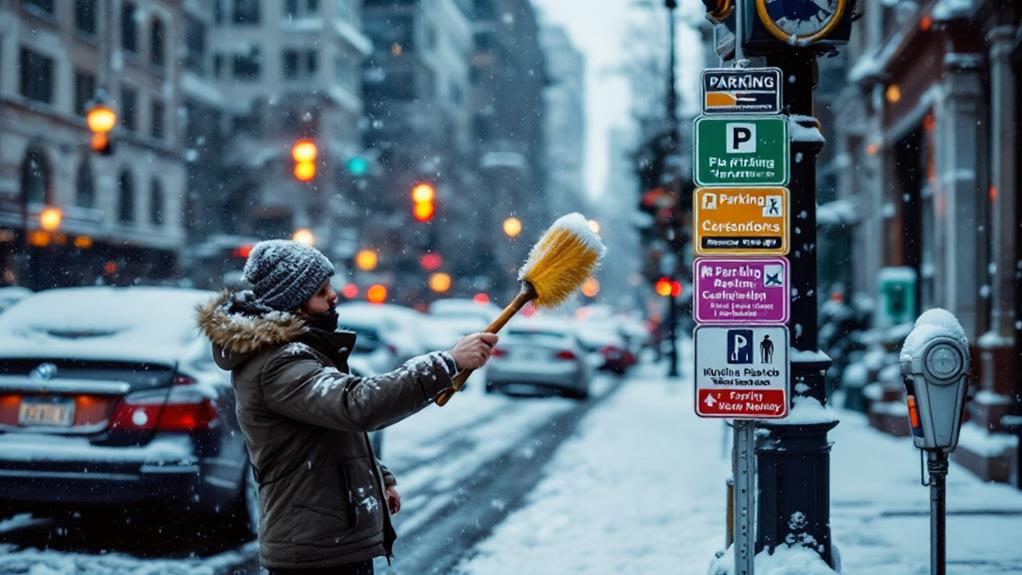
Many cities enforce seasonal parking regulations that can catch unwary drivers off guard. You'll need to stay vigilant as these rules can change throughout the year, affecting where and when parking is allowed.
During winter months, some areas prohibit overnight parking or require special permits to facilitate snow removal. Keep an eye out for designated "snow emergency routes" where you can't park once snow accumulation reaches a certain level. These restrictions guarantee plows can clear streets efficiently.
Conversely, you might find more lenient rules in summer, with some cities allowing street parking that's banned in winter. However, don't assume this applies everywhere – always check local regulations.
Year-round, you'll encounter alternate-side parking rules in many cities. These require you to move your vehicle to the opposite side of the street on specific days, usually for street cleaning purposes.
Parking meters can also have seasonal variations. Time limits may change, or meters might be free on weekends and holidays. Always read posted signs carefully to avoid tickets. By staying informed about these seasonal shifts, you'll traverse street parking regulations with confidence and avoid unnecessary fines.
Parking Etiquette and Courtesy
Parking etiquette goes beyond simply following posted rules and regulations. It's about being considerate of other drivers and the community. When you're looking for a parking space, be patient and avoid blocking traffic. Once you've found a spot, park within the lines and leave enough room for other vehicles to maneuver.
Take Care not to obstruct driveways, fire hydrants, or pedestrian crossings. If you're parallel parking, leave about 12 inches between your car and the curb. When exiting your vehicle, check for cyclists before opening your door to prevent accidents.
Here are some additional courtesies to keep in mind:
- Don't take up multiple spaces with one vehicle
- Avoid unnecessarily loud music or engine noise
- Clean up any trash before leaving your parking space
- Be mindful of your car's exhaust when idling near pedestrians
